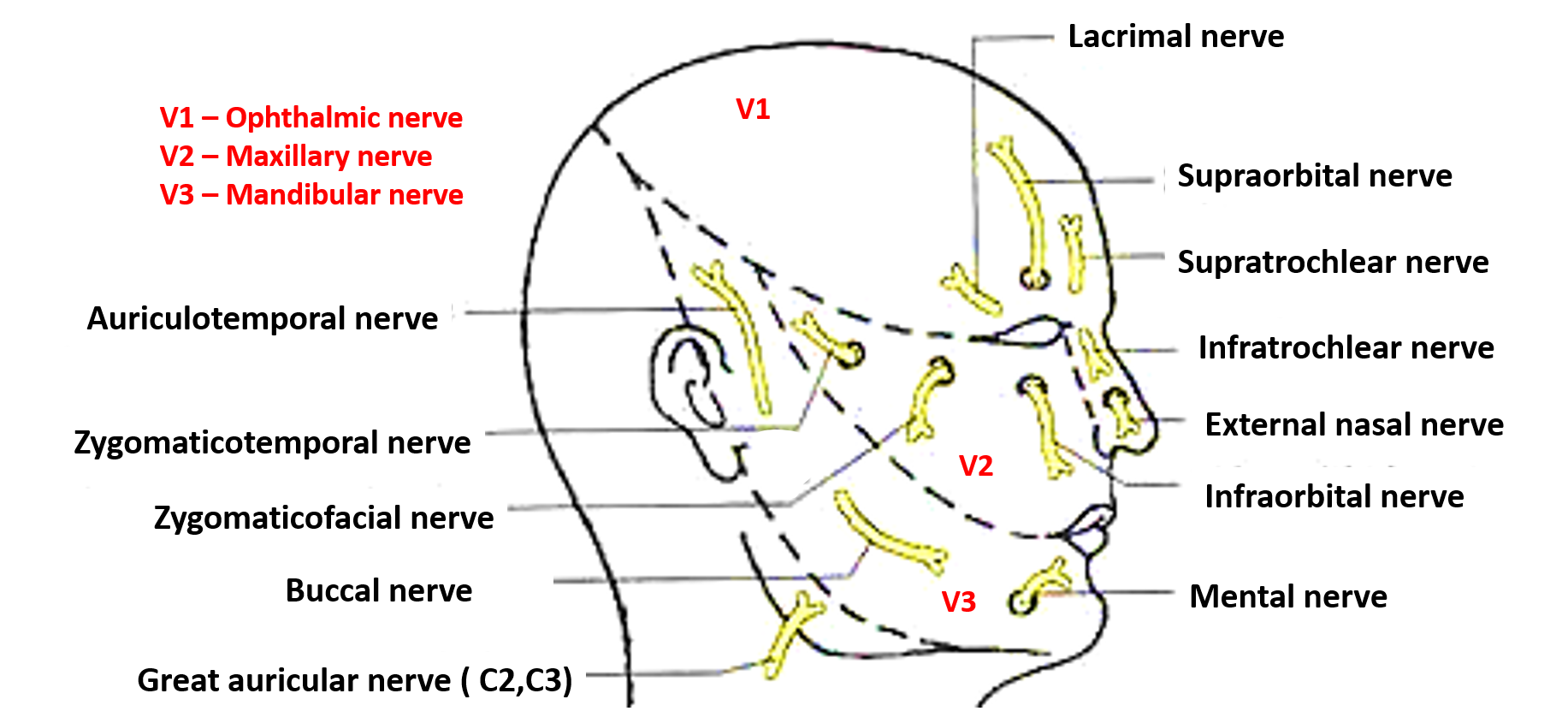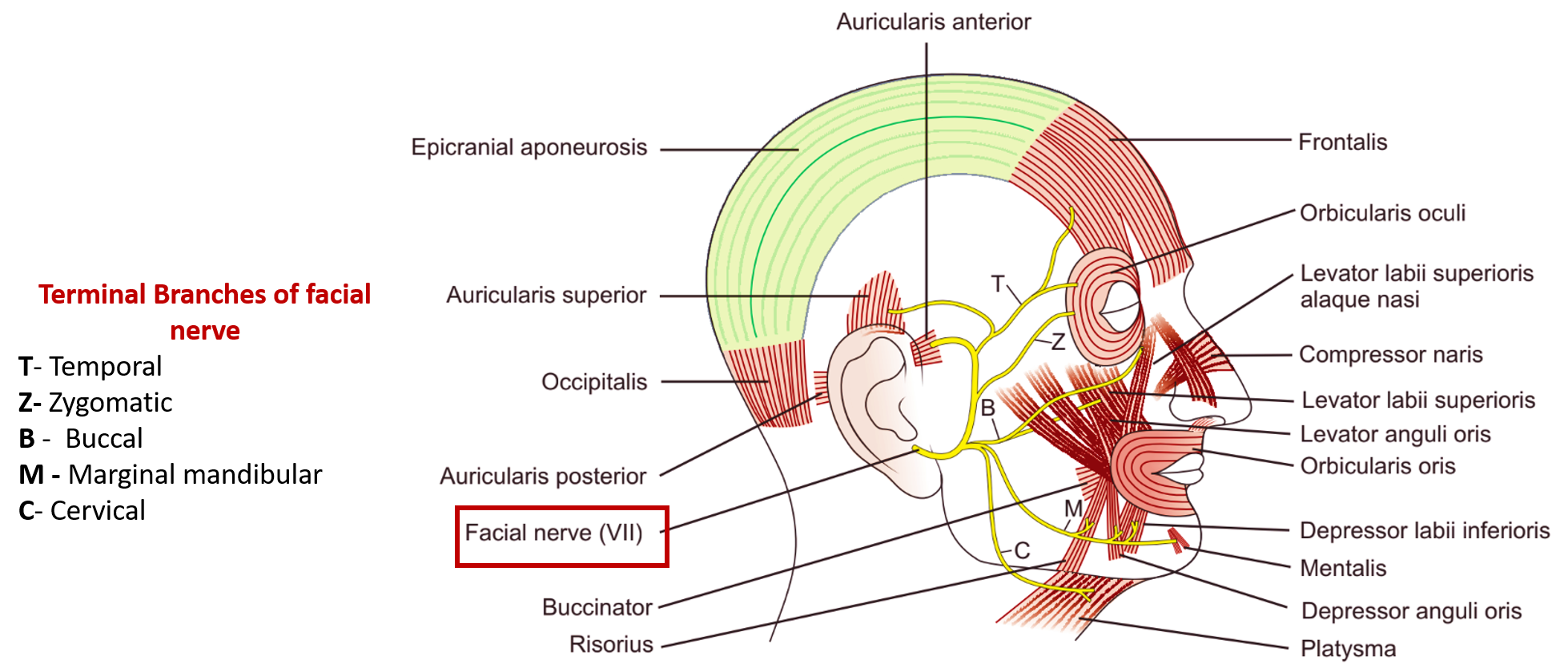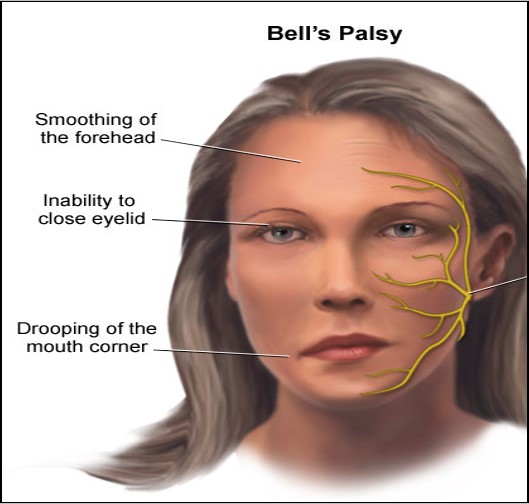Describe sensory innervation of Face.
Skin of face is supplied by the three divisions of trigeminal nerve i.e. ophthalmic, maxillary and mandibular. A small part over the angle of mandible is supplied by great auricular nerve ( from ventral rami of C2,C3 spinal nerves).
Correlation of Sensory Innervation of Face with the Development of Face
Face can be roughly divided into three regions with respect to sensory innervation – upper1/3rd, middle 1/3rd and lower 1/3rd and is mainly supplied by the three divisions of trigeminal nerve i.e. ophthalmic, maxillary and mandibular nerves.
- The upper one-third of face develops from the frontonasal process and is supplied by branches of ophthalmic nerve.
- The middle third of face develops from maxillary processes and is supplied by branches of maxillary nerve.
- The lower third of face develops from mandibular processes and is supplied by branches of mandibular nerve.
However, the areas of cutaneous innervation aren’t horizontal, but extend in the posterosuperior direction corresponding to the direction of development of head and brain. Part of the neck skin is drawn up to overlap the angle of the mandible. This part of the skin is therefore supplied by great auricular (C2).
The branches of the three divisions of trigeminal nerve that supply the skin of face are as follows:
Branches of ophthalmic division of trigeminal nerve
- Supraorbital
- Supratrochlear
- Lacrimal
- Infratrochlear
- External nasal
Branches of maxillary division of trigeminal nerve:
- Infraorbital
- Zygomaticofacial
- Zygomaticotemporal
Branches of mandibular division of trigeminal nerve:
- Mental
- Buccal
- Auriculotemporal

Name the nerve and its branches that supply muscles of Face.
The muscles of face are supplied by the facial nerve. Facial nerve leaves the cranial cavity via stylomastoid foramen, it wind around the lateral aspect of styloid process and enters the parotid gland. Within the parotid gland it gives 5 terminal branches viz.
- temporal
- zygomatic
- buccal
- marginal mandibular
- cervical
The branches emerge along the anterior border of the parotid gland and supply the muscles of facial expression.

| Branches of facial nerve | Muscles Supplied |
|---|---|
| Temporal branch | Frontalis |
| Orbicularis oculi | |
| Corrugator supercilii | |
| Zygomatic branch | Orbicularis oculi |
| Buccal branches | Zygomaticus major and minor |
| Upper buccal branch | Levator labii superioris alaeque nasi. |
| Muscles of the nose | |
| Levator anguli oris | |
| Levator labii superioris | |
| Lower buccal branch | Buccinator |
| Orbicularis oris | |
| Marginal mandibular branch | Risorius. |
| Depressor anguli oris | |
| Depressor labii inferioris | |
| Mentalis | |
| Cervical branch | Platysma |
Applied Aspects
Bell’s palsy
It is lower motor neuron type paralysis of facial muscles which occurs because of compression of facial nerve in the facial canal near stylomastoid foramen. It results in ipsilateral paralysis of facial muscles. The symptoms of Bell’s palsy include:
- Facial asymmetry because of unopposed activity of muscles of normal side.
- Loss of horizontal wrinkles on forehead because of paralysis of frontalis muscle.
- Inability to close the eyes and widening of palpebral fissure because of paralysis of orbicularis oculi.
- Loss of corneal reflex (efferent limb of the reflex is formed by facial nerve).
- Epiphora (tears flow down from the eye) because of paralysis of the lower part of the orbicularis oculi.
- Absence of nasolabial fold because of paralysis of levator labii superioris alaeque nasi.
- Drooling of saliva from corner of mouth because of paralysis of orbicularis oris.
- When the person tries to smile the angle of mouth of the normal side moves upwards and laterally.
- Accumulation of food into the vestibule of mouth because of paralysis of buccinator muscle.

